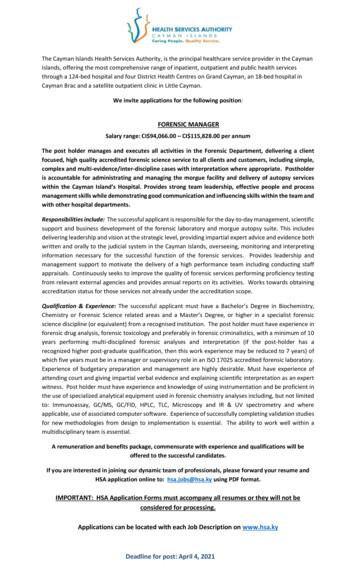FORENSIC INTERVIEWING - Michigan
FORENSIC INTERVIEWINGOFCHILDRENPresented By:PAM MAAS, CHIEF ASSISTANT PROSECUTOR, LIVINGSTON COUNTYJULIE KNOP, DIRECTORCHILD ABUSE TRAINING SERVICESProsecuting Attorneys Association of MI
This training is required by MI law.It is designed to be interactive.It also helps CAC’s receivefunding and allows you to beable to interview at a CAC.
Where does it say I HAVE to use theprotocol?I’m glad you asked!Page 23 of MCL 722.628 within the CPL states:In each county, the prosecuting attorney and the departmentshall develop and establish procedures for involving lawenforcement officials as provided in this section. In each county,the prosecuting attorney and the department shall adopt andimplement standard child abuse and neglect investigation andinterview protocols using as a model the protocols developedby the GTF on children’s justice as published in DHHSPublication 779 (04/11), or an updated version.
How many of you are familiar with your county’sprotocol?
The MDT
History Michigan’s FI protocol was developed in 1996 by child abuse professionals who workin the field of development, interviewing and linguistics. Michigan’s protocol is research and evidence based and is updated every 5 years tostay current and user friendly Dr. Deb Poole is the author and is a world known expert in the field of child linguisticsand development
How did we get the protocol?In 1992 the Governor’s Task Force on Children’s Justice was createdpursuant to federal legislation to respond to the tremendous challengesinvolved in the handling of child abuse particularly child sexual abuse casesin Michigan.In 1993 the Task Force published FIA publication 794, A Model ChildAbuse Protocol – Coordinated Investigative Team Approach.In 1996, the DHS initiated the development of a forensic interviewingprotocol by establishing a committee within DHS and enlisting 9 countyDHS offices to participate as pilot counties in testing the protocol.
1996-1998, DHS and the GTF worked with Dr. Debra Poole in developing andimplementing a protocol that would improve the interviewing techniques of allprofessionals involved in the investigation of child abuse in MI.In 1998, the CPL was amended to require each county to implement a standardchild abuse and neglect investigation and interview protocol using as a model theprotocols developed by the GTF.In 2003, a team convened to review and update the current protocol. The FIprotocol revision committee edited sections for clarity, improved the examples andadded Quick Guides.In 2009 the committee again met to improve the quality of the protocol usingcurrent research and suggestions received by professionals that use the protocol ona regular basis.In 2017 the protocol was again updated to keep up with science and research.
Goal of a Forensic InterviewTo provide more structure to make iteasier for interviewers to do a good joband to help them avoid mistakes.
Places the protocol is used
What does research show?Children err in reporting events not because their memories are so bad, butbecause their memories are so good. They readily absorb general knowledge bothwithin interview settings and outside interview settings. Remembering andmonitoring the source of information, however, is largely irrelevant to the task ofdeveloping during the early years of life.
In 1996, the DHS initiated the development of a forensic interviewing protocol by establishing a committee within DHS and enlisting 9 county DHS offices to participate as pilot counties in testing the protocol. 1996-1998, DHS and the GTF worked with Dr. Debra Poole in developing and
Forensic Science is the integration of core scientific disciplines. Forensic science involves a variety of careers. 1. Students will recognize the major contributors to the development of Forensic . Worksheets Lab; Activity Project assessments Research activities such as “famous forensic scientists and their contributions” or “careers inFile Size: 444KBPage Count: 21People also search forforensic science for high school textbook pdfdo forensic criminologist investigate the cri forensic criminology bookswhat is a dental hygienisthow to check fingerprint forensic criminologyare dental hygienists and dentist same thing
Forensic science is the application of science to law. Any science can be applied into a legal situation, but some of the commonest forensic sciences include forensic biology, forensic chemistry, and forensic toxicology. The word forensic in today’s world simply
forensic science discipline (or equivalent). Experience It is essential that the post holder is an experienced forensic scientist in forensic drug analysis, forensic toxicology and preferably in forensic criminalistics, with a minimum of 10 years performing multi-disciplined forensic
Forensic Psychology Chapter ObjeCtives ·orensic Define f psychology. · Review career areas in the forensic sciences. · Distinguish forensic psychology from forensic psychiatry. · Identify and describe the major subareas of forensic psychology. · Review the educational, training, and certification requirements to become a forensic psychologist.
Delivering forensic services (Report 21: 2018-19) 4 . Summary of audit findings . Delivering forensic services . We audited four types of forensic services: fingerprints, deoxyribonucleic acid(DNA), forensic medical examinations and illicit drugs. Three of these services accounted for approximately 92 per cent of all forensic services .
Forensic Toxicology in Death Investigation Eugene C. Dinovo, Ph.D., and Robert H. Cravey Forensic toxicology is a highly specialized area of forensic science which requires exper tise in analytical chemistry, pharmacology, biochemistry, and forensic investigation. The practicing forensic toxicologist is concerned
Exploring Forensic Anthropology and Forensic Entomology 121 Define the terms : forensic anthropology: and : forensic entomology. 122 Differentiate between a male skeleton and a female skeleton. . Definition should include identifying forensic
Subject: Forensic Science Code No.: 82 SYLLABUS Unit – I Forensic Science: Definition, History & Development, Scope, Ethics in Forensic Science . Forensic Entomology: Introduction, Insects of forensic importance, Insects on























